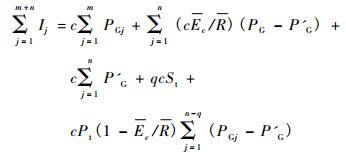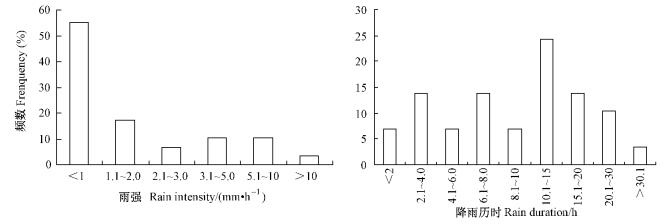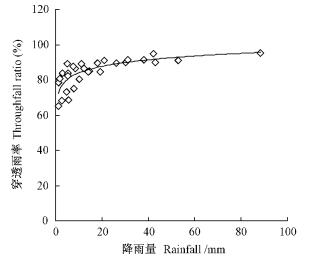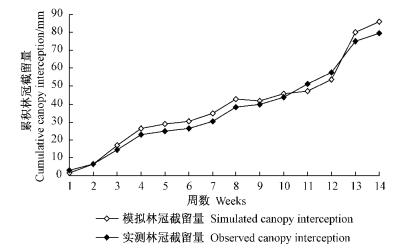文章信息
- 赵洋毅, 王玉杰, 王云琦, 刘楠, 刘敏, 吴云, 陈林
- Zhao Yangyi, Wang Yujie, Wang Yunqi, Liu Nan, Liu Min, Wu Yun, Chen Lin
- 基于修正的Gash模型模拟缙云山毛竹林降雨截留
- Simulation of Canopy Rainfall Interception of the Phyllostachys edulis Forest with the Revised Gash Model in the Jinyun Mountains of Chongqing
- 林业科学, 2011, 47(9): 15-20.
- Scientia Silvae Sinicae, 2011, 47(9): 15-20.
-
文章历史
- 收稿日期:2010-06-03
- 修回日期:2011-08-07
-
作者相关文章
2. 北京林业大学水土保持学院 北京 100083;
3. 重庆缙云山国家级自然保护区管理局 重庆 400700
2. College of Soil and Water Conservation, Beijing Forestry University Beijing 100083;
3. Chongqing Jinyunshan National Nature Protection Region Management Bureau Chongqing 400700
林冠截留作为水文循环的一个重要环节,影响地表-大气能量循环过程和水量平衡(Zeng et al., 2000)。目前,用模型理解和预测林冠截留备受关注。Gash模型是Gash等(1979)以Rutter微气象模型(Rutter et al., 1971)为基础,采用基本的物理推理方法建立的林冠截留解析模型,针对模型在最初的应用中所出现的缺点(Price et al., 2003; Gash et al., 1995),Gash等(1995)和Valente等(1997)又对其进行了修正,使之能适用于稀疏林地。由于结合了经验模型和理论模型的长处,Gash解析模型模拟计算林冠截留量更实用和简单。目前,该模型被广泛应用到世界各地各种林分类型的林冠截留研究中(Gash,1979; Deguchi et al., 2006; Herbst et al., 2006; Carlyle-Moses et al., 1999; Wallace et al., 2008; 王馨等,2006; 何常青等,2010; Návar et al., 1999; Llorens et al., 1997; Šraj et al., 2008; Gómez et al., 2002; Shi et al., 2010; 季冬,2007),但在中国森林的应用还较少,特别是中国亚热带毛竹(Phyllostachys edulis)林。本研究为了验证修正的Gash模型对重庆缙云山毛竹林林冠截留模拟的适用性,利用当地的相关气象和林分特征资料,在分析毛竹林对降雨的再分配规律基础上,应用修正的Gash模型对林冠截留量进行模拟,对比分析模拟值和实测值,并进一步确定模型中影响林冠截留量的敏感参数,为准确评价修正的Gash模型在亚热带毛竹林应用的适宜性及毛竹林的林冠截留作用提供参考。
1 研究区概况研究区位于重庆市北碚区境内嘉陵江小三峡之温塘峡西岸的缙云山自然保护区(106° 22' E,9°49'N),海拔350 ~ 951.5 m,具有亚热带季风湿润性气候,年均气温13.6 ℃,年均降水量1 611.8 mm,年均蒸发量777.1 mm,年均日照1 293.9 h。土壤以酸性黄壤土为主。
缙云山的毛竹林广泛分布,占地466.67 km2。所设毛竹林标准地位于缙云山的狮子峰,面积20 m × 20 m,海拔800 m,坡度11°,西北坡向,林龄13年,郁闭度0.79,平均树高12.9 m,平均胸径10.3 cm,密度3 795株·hm-2。林下主要灌木有地瓜藤(Fieus tikoua)和杜茎山(Maesa subrotunda)等。地被物有蕨类(Antenoron neofi)和莽草(Illicium lanceolatum)等。
2 研究方法修正的Gash模型(Gash et al., 1995; CarlyleMoses et al., 1999)描述的是一系列彼此分离的降雨事件,每个降雨事件都包含林冠加湿、林冠饱和、以及降雨停止后林冠干燥的过程,且假定每次降雨事件之间有足够的时间让林冠完全恢复到降雨前的干燥程度。模型采用分项求和的形式,将整个林冠在降雨过程中各个阶段的截留损失相加得到总的林冠截留量。该模型计算林冠截留量的基本公式为:

|
式中: Ij为林冠截留量(mm); n为林冠达到饱和的降雨次数; m为林冠未达到饱和的降雨次数; j为总的降雨次数; c为林分郁闭度; Pt为树干径流系数; R为平均降雨强度(mm·h-1); Ec为单位覆盖面积平均林冠蒸发速率(mm·h-1); Ec = E/c,E为饱和林冠的平均蒸发速率(mm· h-1); PGj为总的降雨量; PG为单次降雨的降雨量(mm); P'G为使林冠达到饱和的降雨量(mm); q为树干达到饱和产生树干径流的降雨次数; St为树干持水能力(mm)。



2009年4—7月毛竹林标准地内随机布置20个标准雨量筒,于每场降雨后及时测定林内穿透降雨量TF(mm)。根据径级分布,在标准地共选择6株标准木观测树干茎流,采用塑料管环状收集槽,环绕树干2 ~ 3圈,用玻璃胶密封,下部接入塑料桶收集干流,每次降雨后人工测量塑料桶内水的体积,再换算成树干茎流量SF,其计算公式为

|
式中: Sn为每株标准木的树干茎流量(mL); N为单位面积上标准木的株数N = 6; A为标准地的面积(m2)。
根据实测值计算冠层截留量I: I = PG-TF-SF。
国家林业局长江三峡库区(重庆)森林生态定位监测站位于试验样地附近,与本研究相关的林外降雨量、空气温湿度、风速、净辐射等指标由监测站内固定的全自动气象观测系统直接测定得出,林外降雨量由TE525MM雨量计测定,空气温湿度由HMP45C空气温度湿度探头测定,风速由高度15 m的30510型风速和风向探头测定,净辐射由Q7-1净辐射探头测定,净辐射测定高度与平均林冠高度一致,气象站采用PC208W3.2编程自动观测,由CR10X数据采集器自动采集数据,每10 min记录1次,精度满足模型的基本要求。
3 结果与分析 3.1 研究期间林外降雨、林内穿透雨和树干茎流特征研究表明: 2009年4—7月共29次降雨,大部分为低雨强、低雨量级、长历时的降雨,其林外降雨总量为531.1 mm,平均每次降雨18.3 mm,单次雨量1.1 ~ 88.4 mm; 单次降雨雨强为0.1 ~ 13.1 mm·h-1,平均雨强2.11 mm·h-1,变异系数为139.74%。雨强小于1和2 mm·h-1的频度分别达到了55.17%和72.41%,雨强大于5 mm·h-1的频度为13.78% (图 1)。单次降雨历时1.5 ~ 40.83 h,平均每次降雨历时12.09 h,变异系数为79.62%,由图 1可见,降雨历时10.1 ~ 15 h的频数最大。

|
图 1 降雨特征 Figure 1 Rainfall characteristics |
研究期间林内穿透雨量为463.2 mm,占研究期间总降雨量的87.22%,每次降雨穿透雨率65.06% ~ 95.13%,平均每次降雨的穿透雨率达83.35%,降雨量小于10 mm的降雨13次(图 2),最小降雨量仅为1.1 mm,平均穿透雨率为78.66%。穿透雨率与林外降雨量的关系RTF为

|
图 2 穿透雨率与降雨量的关系 Figure 2 Relationship between throughfall ratio and rainfall |
RTF = 5.283 ln(PG) + 71.911,R2 = 0.584,n = 29。
研究表明,29次降雨的穿透雨率变异系数变化范围为9.63% ~ 56.43%。在降雨量PG<10 mm时,穿透雨率为15.78% ~ 56.43%,变异系数较大,且随着降雨量增大其减幅很大; 在降雨量PG>10 mm时,穿透雨率为9.63% ~ 18.53%,变异系数较小,随着降雨量增大其减幅变小。林内穿透雨率变异系数随着降雨量的增大呈逐渐减小的趋势。
研究期间,树干茎流总量为6.5 mm,占研究期间总降雨量的1.23%,单次降雨的平均树干茎流量为0.24 m。观测发现,毛竹林在每次降水开始至林冠蓄水饱和之前,一般不产生茎流,但在连续降雨过程中,因为毛竹秆枝部表面光滑,且被有透水性能很差的坚硬硅化蜡质层,秆枝蓄水容量相对很小,因而林冠达到饱和所要求的降水量相对较小。在降雨量很小,如PG>2 mm时,便会产生树干茎流。平均树干茎流量在降雨量PG<5 mm时仅0.07 mm,5 mm<PG<10 mm时0.11 mm,10 mm<PG<20 mm时0.19 mm,20 mm<PG<40 mm时0.41 mm,PG>40 mm时1.17 mm。树干茎流量与林外降雨量存在如下线性关系: SF = 0.016PG-0.052,R2 = 0.907,n = 21(图 3)。

|
图 3 树干茎流量与降雨量的关系 Figure 3 Relationship between stemflow and rainfall |
对不同观测样树的树干茎流分析表明,树干茎流存在较大变异,树干茎流率为44.26% ~ 153.52%,平均变异系数为87.98%。平均变异系数在降雨量2 mm<PG<5 mm时达137.93%,5 mm<PG<10 mm时达96.51%,10 mm<PG<20 mm时达95.74%,20 mm<PG<40 mm时达67.49%; PG>40 mm时为60.53%。树干茎流率变异系数随着降雨量的增大呈逐渐减小趋势。
3.2 修正的Gash模型参数值林冠持水能力是林冠截留降水的主要影响因子之一,一般采用回归法、尺度上推法和遥感法来估算(Liu,2000)。本研究采用Wallace等(2006)和Limousin等(2008)的回归法确定林冠持水能力(S),即根据林内穿透雨量与林外降雨量关系方程,求得穿透雨量的残差TF(δ),推出穿透雨量残差TF (δ)与林外降雨量的关系,得出方程拐点的降雨量值,用大于此值且残差TF(δ)>0的降雨量(TFδ)与对应的林内穿透雨量做回归方程:TFδ= 0.015PG + 0.277,R2 = 0.961,即S = 0.277。
单位面积的林冠持水能力Sc=S/c,从林分调查结果可知,林分平均郁闭度c = 0.79,从而得到Sc= 0.351。St和Pt则根据树干茎流量与林外降雨量的关系方程确定,其中,St为树干茎流量与降雨量关系方程在y轴截距的负值,Pt为斜率(Limousin et al., 2008)。根据前文已求方程可知,St= 0.052,Pt = 0.016。使树干达到饱和所必需的降雨量Pt' = St/pt(Shi et al., 2010),则P't = 3.25 mm。p为自由穿透降雨系数,即不接触林冠直接降落到林地的降雨的比率,计算公式为p = 1-c,由平均林冠郁闭度(c)可知p = 0.21。饱和林冠的平均蒸发速率E根据Penman-Monteith公式(王馨等,2006; Shi et al., 2010)计算,E = 0.027 mm·h-1。根据平均郁闭度c和Ec=E/c可知单位面积平均林冠蒸发速率Ec为0.034 mm·h-1。P'G的计算公式为

|
根据降雨特征分析可知研究期间的平均降雨强度R为2.11 mm·h-1,根据以上参数值即可计算出P'G = 2.26 mm。
3.3 林冠截留量实测值和模型模拟值对比分析基于2009年4—7月林外降雨、穿透雨和树干茎流数据,计算出缙云山毛竹林穿透雨量、树干茎流量和林冠截留总量的实测值分别为463.2,6.5和61.4 mm; 将已获取的相关参数值代入模型公式,可得到模型各组成部分的数值及对应的模拟值,穿透雨量、树干茎流量和林冠截留总量模拟值分别为461.1,6.1和63.9 mm(表 1)。可见,林冠截留总量的模拟值比实测值高2.6 mm,相对误差为4.07%,穿透雨和树干茎流量的模拟值与实测值相比分别低2.1和0.4 mm,相对误差分别为0.45%和6.15%。从模型模拟的各组成部分数值来看(表 1),用于饱和冠层的降雨量占模拟林冠截留总量的百分比达到65.41%,是林冠截留的主要组成部分; 降雨过程中的蒸发量和降雨后的蒸发量占模拟林冠截留总量的百分比分别为7.36%和7.20%,这与研究期间该区低雨强、低雨量级、长历时的降雨特征和较低蒸发速率(如饱和林冠的平均蒸发速率仅为0.017 mm·h-1)有关; 未能饱和冠层的降雨量为3.2 mm,仅占模拟林冠截留总量的5.01%,这是因为在雨量较小时对截留起主要作用的是林冠郁闭度,而对于雨量较大的降雨,影响林冠截留的因素较多,如林冠郁闭度、林冠蒸发强度和树干茎流等。
|
|
Gash等(1995)最初对模型进行修正后,主要是应用于对林冠截留的周累积量的估算。通过修正的Gash模型对林冠截留周累积量的模拟和实测值的比较(图 4)可知,2者的相对标准误差为5.02%,说明应用修正的Gash模型对缙云山毛竹林林冠截留的周累积量的模拟效果较好。通过研究期间模型模拟单次降雨的林冠截留量与实测值比较(图 5)可知,2者同样具有较好的一致性,相对标准误差为7.13%。在雨量较小时,模型对单场降雨林冠截留的预测准确性更高,预测的准确性随着雨量增大呈下降趋势。因此,可以看出运用修正的Gash模型来模拟缙云山毛竹林林冠截留具有较好的适用性,模拟的准确性较高。

|
图 4 林冠截留周累积量实测值和模拟值 Figure 4 Observed and simulated weekly cumulative canopy interception |

|
图 5 单次降雨林冠截留量的实测值和模拟值 Figure 5 Observed and simulated canopy interception of single rainfall event |
为确定修正的Gash模型中的参数对林冠截留总量的影响程度,对R,E,S,St,Pt和c进行参数敏感性检验。由图 6可知,6个参数中林冠郁闭度c对林冠截留量的影响最大,其余依次为平均降雨强度R、林冠持水能力S和林冠平均蒸发速率E,树干茎流系数Pt和树干持水能力St的影响最小。c,S,E和Pt值每增加10%,林冠截留总量分别增加14.89%,1.39%,0.77%和0.19%; R值每增加10%,林冠截留总量减少2.29%; St值每增加10%,林冠截留总量仅增加0.06%。林分完全郁闭c = 1时,林冠截留总量的预测值将比实测值高29.62%。

|
图 6 修正的Gash模型参数变化的敏感性分析 Figure 6 Sensitivity analysis of parameters of the revised Gash analytical model |
研究期间,缙云山毛竹林的穿透雨率和树干茎流率的变异系数与降雨量呈显著负相关(P<0.01),这与多数研究结果相似(Price et al., 2003; Deguchi et al., 2006; Wallace et al., 2008; 时忠杰等,2009)。这与毛竹林穿透雨及干流受降水强度、林冠潮湿状况、大气温度及湿度、林木个体大小、叶面积指数、立竹度等多方面因素有关。
应用修正的Gash模型模拟缙云山毛竹林林冠截留周累积量和单次降雨截留量,并分别与实测值进行比较,周积累量的相对标准误差更小,模拟效果更好; 模型对单次降雨林冠截留量的预测在雨量较小时准确性更高,预测的准确性随着雨量增大呈下降趋势。总体来看,模型能够很好地模拟缙云山毛竹林林冠截留过程。
模型参数(R,E,S,St,Pt和c)对林冠截留量的影响以冠层郁闭度c最大,其次是平均降雨强度R、林冠持水能力S和林冠平均蒸发速率E,以树干茎流系数Pt和树干持水能力St最小。limousin等(2008)和Shi等(2010)认为影响最大的参数是林冠郁闭度c,而Deguchi等(2006)认为E的影响最大,何常清等(2010)研究得出林冠持水能力S的影响最大。
修正的Gash模型是目前比较常用和有效的降雨截留模型,该模型综合了林分、降雨和空气动力学3方面特征,具有较好的物理学基础,把林冠截留总量划分成几个组成部分,这样对林冠截留的过程能够有充分的理解。国内外一些研究已证明即使是在不同的气候、地理位置或是林分类型条件下,修正的Gash模型在模拟林冠截留时效果仍然较好。通过本研究可知,修正的Gash解析模型适用于西南亚热带的缙云山毛竹林。
何常清, 薛建辉, 吴永波, 等. 2010. 应用Gash解析模型对岷江上游亚高山川滇高山栎林林冠截留的模拟[J]. 生态学报, 30(5): 1125-1132. |
季冬. 2007. 贡嘎山暗针叶林林冠截留的Gash模型. 北京林业大学水土保持学院硕士学位论文. http://cdmd.cnki.com.cn/Article/CDMD-10022-2007076944.htm
|
时忠杰, 王彦辉, 徐丽宏, 等. 2009. 六盘山华山松(Pinus armandii)林降雨再分配及其空间变异特征[J]. 生态学报, 29(1): 76-85. |
王馨, 张一平, 刘文杰. 2006. Gash模型在热带季节雨林林冠截留研究中的应用[J]. 生态学报, 26(3): 722-720. |
Carlyle-Moses D E, Price A G. 1999. An evaluation of the Gash interception model in a northern hardwood stand[J]. Journal of Hydrology, 214(3): 103-110. |
Deguchi A, Hattori S, Park H T. 2006. The influence of seasonal changes in canopy structure on interception loss: application of the revised Gash model[J]. Journal of Hydrology, 318(1): 80-102. |
Gash J H C. 1979. An analytical model of rainfall interception by forests[J]. Quarterly Journal of the Royal Meteorological Society, 105(443): 43-55. DOI:10.1002/(ISSN)1477-870X |
Gash J H C, Lloyd C R, Lachaud G. 1995. Estimating sparse forest rainfall interception with an analytical model[J]. Journal of Hydrology, 170(1): 79-86. |
Gómez J A, Vanderlinden K, Giráldez J V, et al. 2002. Rainfall concentration under olive trees[J]. Agricultural and Forest Meteorology, 55(1): 53-70. |
Herbst M, Roberts J M, Rosier P T W, et al. 2006. Measuring and modeling the rainfall interception loss by hedgerows in Southern England[J]. Agricultural and Forest Meteorology, 141(4): 244-256. |
Llorens P, Poch R, Latron J, et al. 1997. Rainfall interception by a Pinus sylventris forest patch overgrown in a Mediterranean mountainous abandoned area. I. Monitoring design and results down to the event scale[J]. Journal of Hydrology, 199(4): 331-345. |
Limousin L M, Rambal S, Ourciva J M, et al. 2008. Modelling rainfall interception in a Mediterranean Quercus ilex ecosystem: lesson from a throughfall exclusion experiment[J]. Journal of Hydrology, 357(2): 57-66. |
Liu S. 2000. Estimation of rainfall storage capacity in the canopies of cypress wetlands and slash pine uplands in North-Central Florida[J]. Journal of Hydrology, 207(1): 32-41. |
Návar J, Charles F, Jurado E. 1999. Spatial variations of interception loss components by tamaulipan thornscrub in northeastern Mexico[J]. Forest Ecology and Management, 124(3): 231-239. |
Price A G, Carlyle-Moses D E. 2003. Measurement and modeling of growingseason canopy water fluxes in a mature mixed deciduous forest stand, south Ontario, Canada[J]. Agricultural Forest Meteorology, 119(1): 69-85. |
Rutter A J, Kershaw K A, Robins P C. 1971. A predictive model of rainfall interception in forests[J]. Agricultural Meteorology, 72(9): 367-384. |
Shi Z J, Wang Y H, Xu L H, et al. 2010. Fraction of incident rainfall within the canopy of a pure stand of Pinus armandiiith revised Gash model in the Liupan Mountains of China[J]. Journal of Hydrology, 2(3): 1-7. |
Šraj M, Brilly M, Mikoš M. 2008. Rainfall interception by two deciduous Mediterranean forests of contrasting stature in Slovenia[J]. Agricultural and Forest Meteorology, 148(1): 121-134. DOI:10.1016/j.agrformet.2007.09.007 |
Valente F, David J S, Gash J H C. 1997. Modelling interception loss for two sparse eucalypt and pine forests in central Portugal using reformulated Rutter and Gash analytical models[J]. Journal of Hydrology, 190(2): 141-162. |
Wallace J, McJannet D. 2006. On interception modeling of a lowland coastal rainforest in northern Queensland, Australia[J]. Journal of Hydrology, 329(3): 477-488. |
Wallace J, McJannet D. 2008. Modeling interception in coastal and montane rainforests in northern Queensland, Australia[J]. Journal of hydrology, 348(4): 480-495. |
Zeng N, Shuttleworth J W, Gash J H C. 2000. Influence of temporal variability of rainfall on interception loss. Part Ⅰ[J]. Point analysis. Journal of Hydrology, 228(4): 228-241. |
 2011, Vol. 47
2011, Vol. 47


